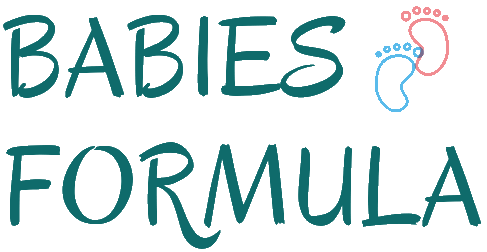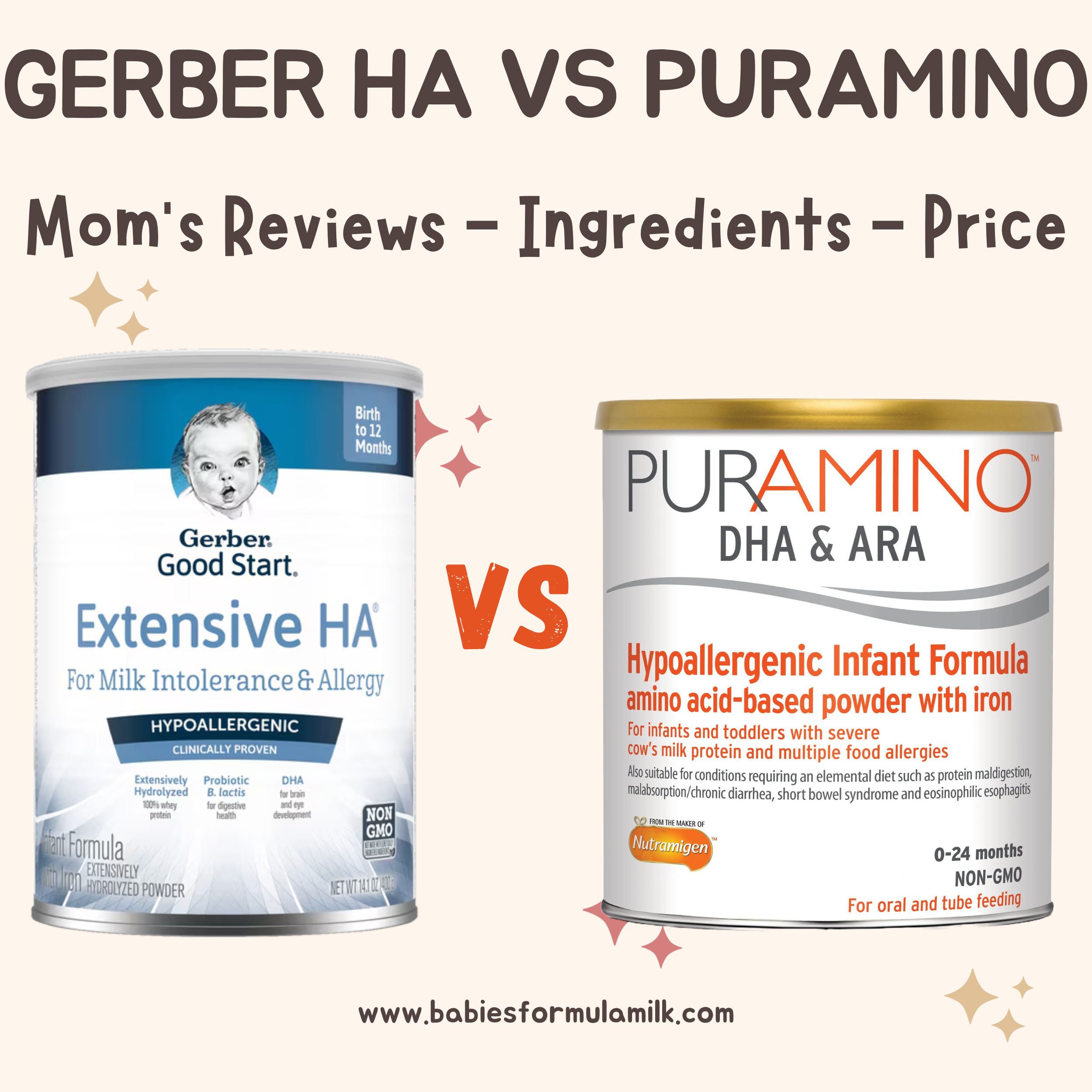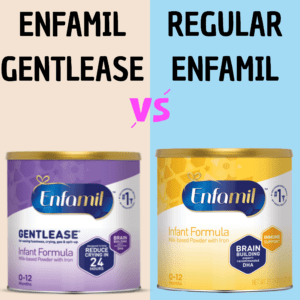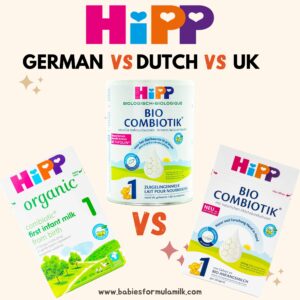Key Differences?
Puramino is an amino acid-based formula suitable for severe allergies (CMPA, MSPI, GERD..), while Gerber Extensive HA is a hypoallergenic formula that contains extensively hydrolyzed protein designed to address mild to moderate sensitivities. The choice depends on the level of sensitivity your baby experiences.
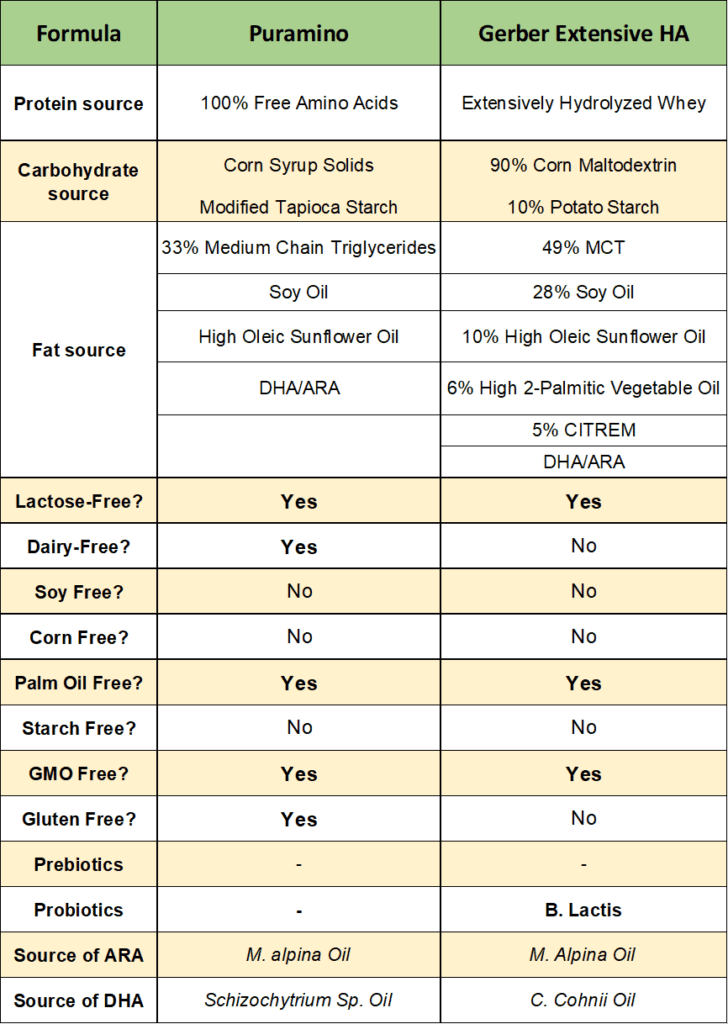
“When you buy something using my links, I may earn a small commission at no additional cost to you. This is a kind of support to me. This website doesn’t accept money for reviews. “
The Best One?
Choosing between Gerber Extensive HA and Puramino depends on your baby’s specific needs and any dietary restrictions they may have.
Gerber Extensive HA is an excellent option for infants with cow’s milk protein intolerance and lactose intolerance or casein protein. It is also more budget-friendly and has shown effectiveness in addressing gas, diaper rash, and regular bowel movements. However, its suitability for more severe allergies is limited because some babies’ immune systems can detect even the extensively hydrolyzed protein.
Puramino, on the other hand, is a robust choice for babies with a broader range of allergies, including CMPA, MSPI, lactose, and gluten intolerance. It offers a variety of benefits, such as helping with reflux, gas, eczema, blood in stools, tummy problems, and supporting healthy weight gain. Additionally, it’s enriched with minerals. However, it comes at a higher cost.
Mom’s Reviews Comparison:

Gerber Extensive HA:
- Positive Reviews:
- Many mothers have found Gerber Extensive HA to be a saving grace for babies with Cow’s Milk Protein Allergy (CMPA). It is often praised for effectively addressing the symptoms associated with CMPA, such as excessive gas, reflux, and diaper rash. Some moms have also noted that it helps in regulating their baby’s bowel movements.
- The formula has received appreciation for not having the overpowering smell that is often associated with hypoallergenic formulas. This aspect can make feeding time more pleasant for both parents and babies.
- Being GMO-free is another advantage, reassuring parents concerned about the ingredients in their baby’s food.
- Negative Reviews:
- While Gerber Extensive HA is relatively more affordable than some other hypoallergenic formulas, it is still considered expensive, which can be a drawback for budget-conscious parents.
- Availability can be an issue for some, with reports of it being hard to find in physical stores, leading to the inconvenience of needing to purchase it online regularly.
- Taste is subjective, and some babies might not find Gerber Extensive HA very palatable. This can result in feeding challenges and may require patience in getting your baby accustomed to the taste.
- Some babies experience side effects such as constipation and reflux, which can be concerning for parents. Additionally, the smaller can size might not last a full week, necessitating more frequent purchases.
You may notice that I mention reflux in positive and negative reviews because I found that 14 moms have reported the ability of Gerber HA in relieving reflux and 14 other moms have said that it worsened reflux in their babies.
Puramino:
- Positive Reviews:
- Puramino is highly regarded for its efficacy in addressing severe allergies, including Cow’s Milk Protein Allergy (CMPA) and Multiple Food Protein Allergies (MSPI). It is also suitable for infants with lactose intolerance.
- Many moms have reported improvements in their baby’s health, including a reduction in issues like reflux, gas, and eczema, which can be particularly distressing for babies with allergies.
- Puramino’s ability to help babies gain weight has earned it praise from parents and healthcare professionals alike.
- Similar to Gerber Extensive HA, Puramino is also GMO-free, providing peace of mind to parents concerned about the quality of ingredients.
- Negative Reviews:
- Cost is a significant concern for many parents when it comes to Puramino. It is often described as expensive, which can be a barrier for families on a tight budget. This cost factor can lead parents to explore other, more affordable options.
- Some babies may find the taste and smell of Puramino unappealing. This can result in feeding challenges, as infants might be reluctant to consume it.
- Like Gerber Extensive HA, Puramino is not without its side effects, as some babies may experience constipation and spit-up after consumption because every baby is different, and what works for some may not work for others.
Related: Gerber Extensive HA VS Neocate: What’s The Difference?
Ingredients Comparison:
Protein Source:
Gerber Extensive HA uses extensively hydrolyzed whey protein. This means that the proteins in the formula have been broken down into smaller fragments, which can be easier for some babies to digest. It’s a suitable option for babies with allergies or sensitivities to intact cow’s milk proteins, as the hydrolysis process reduces the likelihood of triggering allergic reactions.
Puramino, on the other hand, uses free amino acids as its protein source. Free amino acids are the building blocks of proteins and are in their simplest form, making them extremely easy for the body to absorb. This makes Puramino an ideal choice for babies with severe allergies or sensitivities, as it eliminates the risk of allergic reactions associated with intact or hydrolyzed proteins.
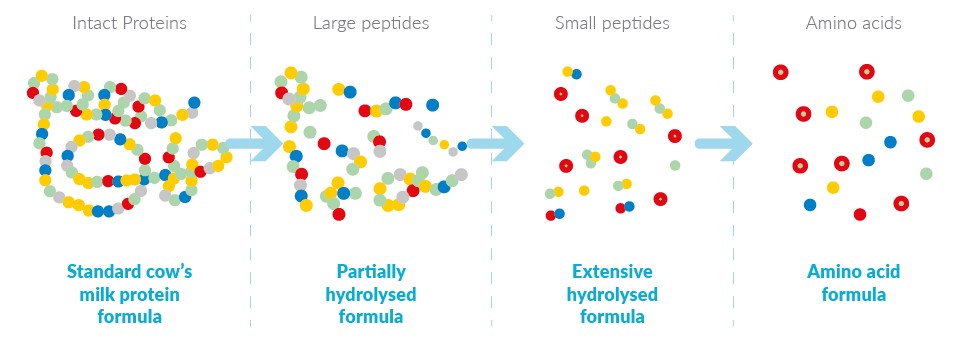
Carbohydrate Source:
Gerber Extensive HA primarily relies on a carbohydrate blend composed of 90% corn maltodextrin and 10% potato starch. Maltodextrin is a common carbohydrate source in many infant formulas and provides a readily available source of energy for babies. The inclusion of potato starch adds variety to the carbohydrate profile.
Puramino, in contrast, uses corn syrup solids and modified tapioca starch as its carbohydrate source. Corn syrup solids are a source of simple carbohydrates, while modified tapioca starch offers a different texture and source of carbohydrates.
Fat Source:
Gerber Extensive HA contains a diverse blend of fats, with 46% medium-chain triglycerides (MCT), 28% soy oil, 10% high oleic sunflower oil, 6% high 2-palmitic vegetable oil, and 5% CITREM (an emulsifier). MCTs are easily digestible and provide a quick source of energy. The inclusion of various oils helps mimic the composition of breast milk and provides essential fatty acids.
Puramino primarily relies on a combination of 33% medium-chain triglycerides (MCTs), soy oil, and high oleic sunflower oil. MCTs are beneficial for easy absorption and energy production. Soy oil and high oleic sunflower oil contribute to the overall fat content.
Related: EleCare VS Gerber Extensive HA: What’s The Difference?
Prebiotics/Probiotics:
Gerber Extensive HA contains the probiotic B. Lactis, which is a beneficial bacterium known for its potential to support digestive health. However, it doesn’t include prebiotics, which are non-digestible fibers that serve as food for probiotics and help promote their growth and activity.
Puramino does not include either prebiotics or probiotics in its formulation.
Nutrients Comparison:
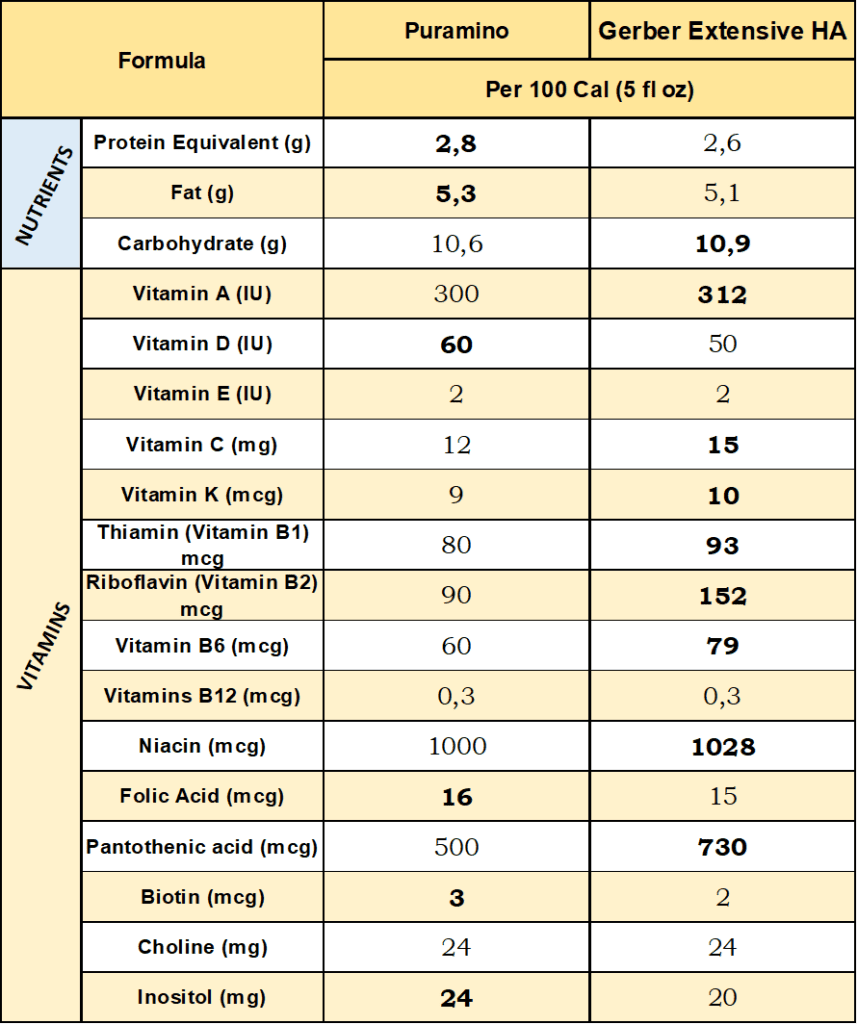
Micronutrients:
Gerber Extensive HA, with its higher carbohydrate content, may provide a greater source of energy through carbohydrates, which can be beneficial for infants who require a higher carbohydrate intake for their growth and development.
Puramino, with its higher protein and fat content, might offer more essential amino acids and fatty acids, which are crucial for your baby’s growth, brain development, and overall health.
Related: Alfamino VS Gerber Extensive HA: What’s The Difference?
Vitamins:
Gerber Extensive HA appears to have a higher content of various vitamins, including Vitamin A, Vitamin C, Vitamin K, Vitamin B1 (Thiamin), Vitamin B6, Vitamin B2 (Riboflavin), Niacin, and Pantothenic acid (Vitamin B5). These vitamins play essential roles in various bodily functions, including immunity, energy metabolism, and overall growth and development.
Puramino, on the other hand, provides more significant amounts of Vitamin D, Folic acid (Vitamin B9), Inositol, and Biotin (Vitamin B7). Vitamin D is vital for bone health and calcium absorption, while Folic acid is crucial for cell division and growth. Inositol and Biotin have roles in various metabolic processes, including cellular signaling and energy production.
Minerals:

Gerber Extensive HA contains higher levels of Magnesium and Copper, which are essential minerals for various bodily functions. Magnesium plays a role in bone health, muscle function, and energy production, while Copper is involved in the formation of red blood cells and connective tissues.
Puramino, on the other hand, provides more substantial amounts of several minerals, including Calcium and Phosphorus (critical for bone health), Manganese (important for enzyme function), Selenium (an antioxidant mineral), Chloride (essential for maintaining fluid balance), Potassium (vital for heart and muscle function), and Sodium (necessary for electrolyte balance).
Price Comparison:
| Puramino | Gerber Extensive HA |
|---|---|
| 44.82 $ 14.1 oz 3.18 /oz Buy HERE | 14.1 oz 26.47 $ 1.88 /oz Buy HERE |
| No Liquid | No Liquid |
| 4.7 of 5.0 718 Rating (Amazon) | 4.1 of 5.0 134 Rating (Walmart) |
In terms of price, there’s a notable difference between Gerber Extensive HA and Puramino.
Gerber Extensive HA is more budget-friendly, costing approximately $1.88 per ounce for its 14.1 oz container.
Puramino, on the other hand, is comparatively more expensive at around $3.18 per ounce for the same 14.1 oz container.
This price difference can be a significant factor for parents, especially those on a tight budget. However, it’s important to consider that the choice between these formulas should also be based on your baby’s specific dietary needs and any recommendations from your healthcare provider. If budget constraints are a concern, Gerber Extensive HA may be a more cost-effective option while still providing essential nutrition for babies with allergies or sensitivities.
How to Switch From Gerber Extensive HA to Puramino?
Switching from Gerber Extensive HA to Puramino, or making any formula change for your baby, should be done gradually to minimize potential digestive discomfort. Here’s a step-by-step guide on how to make the transition:
- Consult Your Pediatrician: Before making any formula switch, it’s essential to consult with your pediatrician or healthcare provider. They can assess your baby’s specific needs and offer personalized guidance on the transition.
- Plan the Transition: Based on your pediatrician’s recommendation, determine the ideal timeframe for the switch. Typically, the transition period can range from several days to a week or more.
- Gather Supplies: Ensure you have both Gerber Extensive HA and Puramino formula on hand, as well as clean bottles and nipples.
- Start Gradually: Begin by mixing the two formulas to create a blend. For the first feeding, mix 25% Puramino with 75% Gerber Extensive HA. This means that if your baby typically consumes 6 ounces of formula, you would mix 1.5 ounces of Puramino with 4.5 ounces of Gerber Extensive HA.
- Observe Your Baby: Pay close attention to your baby’s response during this initial transition phase. Watch for signs of discomfort, such as excessive gas, fussiness, or changes in bowel movements. If your baby tolerates the blend well, you can gradually increase the ratio of Puramino over the next few days.
- Adjust the Ratio: Over the next few days to a week, continue adjusting the ratio of Puramino to Gerber Extensive HA. For example, you can increase the ratio to 50% Puramino and 50% Gerber Extensive HA, and then further to 75% Puramino and 25% Gerber Extensive HA until you eventually transition to 100% Puramino.
- Monitor Your Baby’s Response: Throughout the transition, keep a close eye on your baby’s comfort and overall well-being. If you notice any adverse reactions or if your baby is struggling with the change, consult your pediatrician for guidance.
- Stay Hydrated: Make sure your baby stays well-hydrated during the transition. Offer water or breast milk/formula as needed to prevent dehydration.
- Be Patient: Remember that every baby is unique, and some may adapt to the new formula more easily than others. It’s essential to be patient and flexible throughout the process.
- Complete the Transition: Once your baby is comfortably consuming 100% Puramino and experiencing no adverse effects, you have successfully completed the transition.
Always consult with your pediatrician before making any significant changes to your baby’s diet, and follow their guidance closely to ensure a smooth and safe transition from Gerber Extensive HA to Puramino.
Conclusion:
In conclusion, if your baby has specific allergies or sensitivities, Puramino may be the more comprehensive solution, offering relief for a broader range of issues. If your baby’s sensitivities are less severe or if budget constraints are a concern, Gerber Extensive HA could be a suitable choice. Always consult with your pediatrician to determine the best formula based on your baby’s unique needs.
